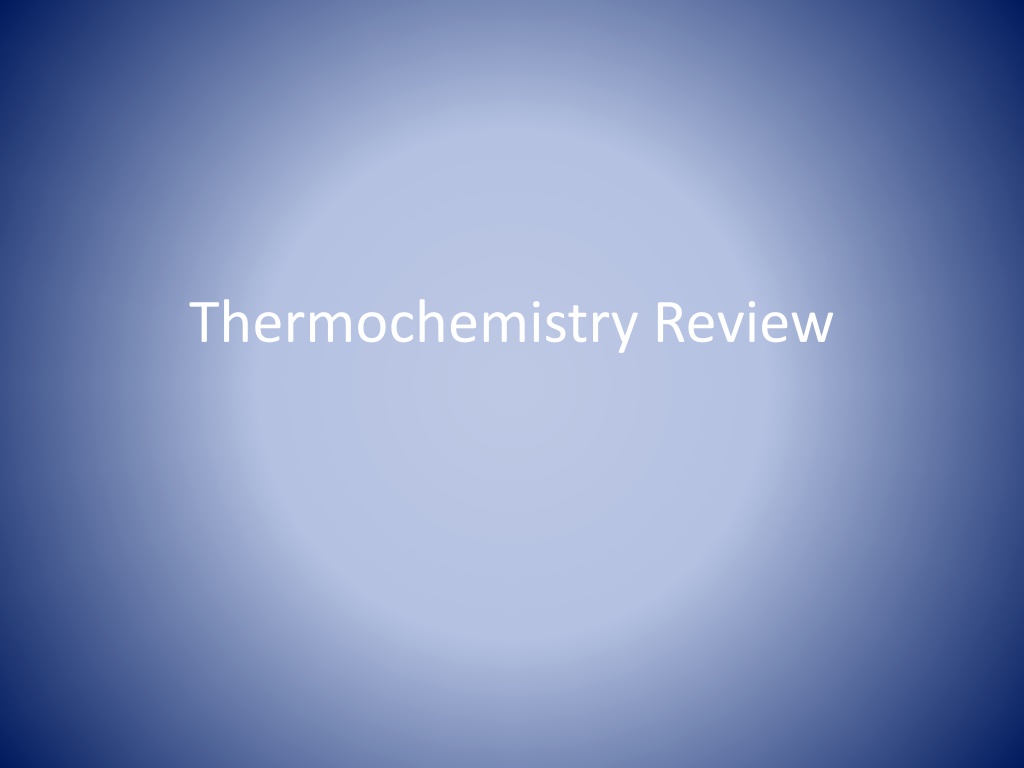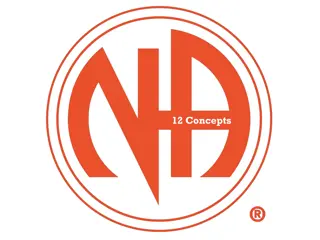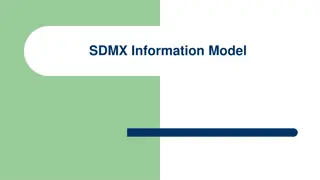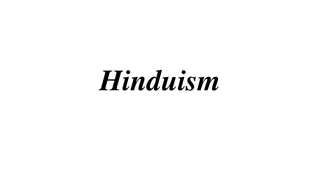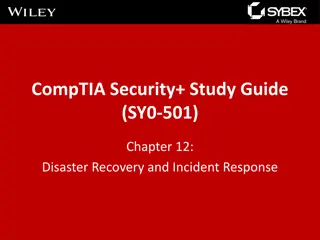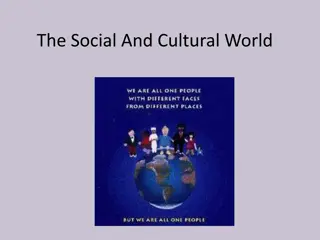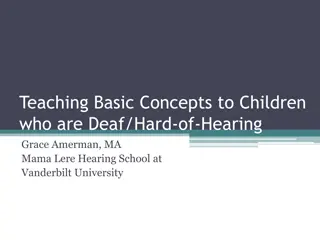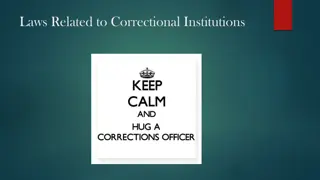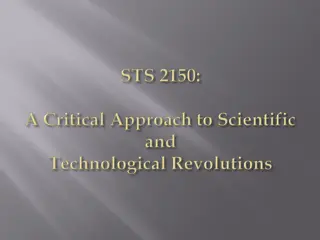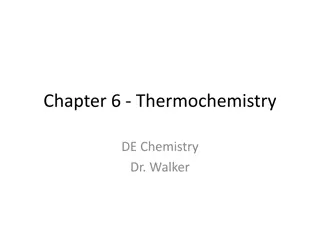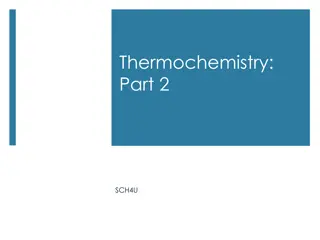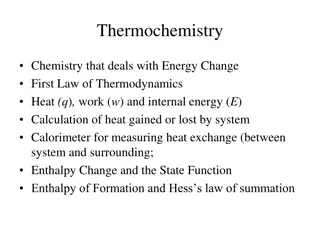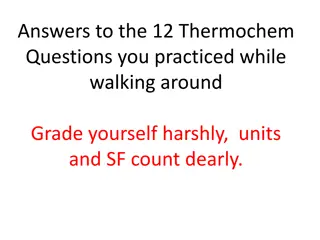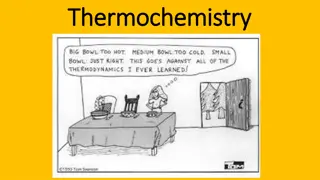Understanding Thermochemistry Concepts
Explore essential thermochemistry topics through a series of questions covering temperature scales, heat transfer, phase changes of water, and more. Test your knowledge and deepen your understanding of key concepts in thermochemistry.
Download Presentation

Please find below an Image/Link to download the presentation.
The content on the website is provided AS IS for your information and personal use only. It may not be sold, licensed, or shared on other websites without obtaining consent from the author. Download presentation by click this link. If you encounter any issues during the download, it is possible that the publisher has removed the file from their server.
E N D
Presentation Transcript
The number of degrees between the freezing point of water and the boiling point of water on the Celsius scale is: 1. 0 2. 100 3. 180 4. 273 0% 0% 0% 0% 0 100 180 273
The smallest change in temperature is represented by: 1. one Celsius degree 2. one Fahrenheit degree 3. one Kelvin 4. one centigrade degree 0% 0% 0% 0% one Kelvin one Celsius degree one Fahrenheit degree one centigrade degree
If the same amount of heat were applied to four samples, which sample would have its temperature raised the most? 1. c = 0.200 J/goC 2. c = 0.450 J/goC 3. c = 0.650 J/goC 4. c = 2.200 J/goC 0% 0% 0% 0% c = 0.200 J/go... c = 0.450 J/go... c = 0.650 J/go... c = 2.200 J/go...
Which of the following tools would be used in an experiment to calculate heat transfer between two objects? 1. Calorimeter 2. Barometer 3. Thermometer 4. Meter Rule 5. More than one correct answer 0% 0% 0% 0% 0% Barometer Thermometer Calorimeter Meter Rule More than one ...
List the phases of water in order, from the phase with the slowest molecular movement to the phase with the fastest molecular movement. 1. Gas-Liquid-Solid 2. Liquid-Solid-Gas 3. Solid-Liquid-Gas 4. Gas-Solid-Liquid 0% 0% 0% 0% Gas-Liquid-Solid Gas-Solid-Liquid Liquid-Solid-Gas Solid-Liquid-Gas
The temperature at which water changes to steam is known as the: 1. boiling point. 2. evaporation temperature. 3. sublimation plateau. 4. melting point. 0% 0% 0% 0% boiling point. melting point. sublimation plateau. evaporation temperature.
When you put ice in a drink to cool it: 1. coldness is transferred from the ice to the warmer drink. 2. heat is transferred from the warmer drink to the cooler ice. 3. heat from the ice is lost to the warmer liquid around it. 4. the ice cracks and releases cold air molecules that cool off the drink. 0% 0% 0% 0% heat from the ice is lost t... the ice cracks and releas.. heat is transferred from ... coldness is transferred fr..
The amount of thermal energy or heat stored in an object depends on: 1. the mass of the object. 2. the temperature of the object. 3. the amount of energy that the particular material stores per degree of temperature. 4. All of the above 0% 0% 0% 0% All of the above the mass of the object. the amount of energy th.. the temperature of the...
The quantity of heat required to change the temperature of a substance by 1C is defined as ____. 1. a joule 2. specific heat 3. a kilocalorie 4. heat capacity 25% 25% 25% 25% a joule specific heat a kilocalorie heat capacity
What is the name of the phase change with snow forms? 1. Evaporation 2. Freezing 3. Deposition 4. Condensation 5. Boiling 6. Melting 17% 17% 17% 17% 17% 17% Freezing Melting Boiling Deposition Evaporation Condensation
What is the name of the phase change with water forms on the bathroom mirror when you shower? 1. Evaporation 2. Freezing 3. Deposition 4. Condensation 5. Boiling 6. Melting 100% Enter answer text...
When thermal energy flows, it raises the temperature of some substances more than others. This property of a substance is called: 1. specific heat. 2. latent heat. 3. dew point. 4. equilibrium. 0% 0% 0% 0% dew point. equilibrium. latent heat. specific heat.
If you hold a paper cup containing hot chocolate in your hand, thermal energy: 1. does not flow. 2. flows from the air to the hot chocolate. 3. flows from the hot chocolate to your hand. 4. flows from your hand to the hot chocolate. 0% 0% 0% 0% does not flow. flows from your hand to... flows from the hot choc... flows from the air to the...
Which of the following has a melting point greater than room temperature? 1. oxygen 2. water 3. iron 4. bromine 0% 0% 0% 0% iron water bromine oxygen
Which of the following about an ice cube floating in a glass of water is correct? 1. The temperature of the ice cube increases. The temperature of the ice cube decreases. The temperature of the ice cube remains constant. The temperature of the ice cube will fluctuate. 2. 3. 4. 0% 0% 0% 0% The temperature of the ... The temperature of the i.. The temperature of the i.. The temperature of the i..
The quantity of heat required to change the temperature of 1 g of a substance by 1C is defined as ____. 1. a joule 2. specific heat 3. a kilocalorie 4. heat capacity 25% 25% 25% 25% a joule specific heat a kilocalorie heat capacity
Which of the following substances has the highest specific heat? 1. steel 2. water 3. alcohol 4. chloroform 0% 0% 0% 0% steel water alcohol chloroform
The amount of heat needed to melt solid at a constant temperature is called ____. 1. heat of fusion 2. heat of solidification 3. heat of reaction 4. heat of vaporization 0% 0% 0% 0% heat of fusion heat of solidi... heat of reacti... heat of vapori...
During a phase change, the temperature of a substance ____. 1. increases 2. decreases 3. remains constant 4. may increase or decrease 0% 0% 0% 0% decreases increases remains constant may increase or decrease
Which of the following is equal to 273 Kelvin? 1. -20 Celsius 2. 0 Celsius 3. 273 Celsius 4. 373 Celsius 0% 0% 0% 0% 0 Celsius -20 Celsius 273 Celsius 373 Celsius
To calculate the amount of heat absorbed as a substance melts, which of the following information is NOT needed? 1. the mass of the substance 2. the specific heat of the substance 3. the change in temperature 4. the density of the sample 0% 0% 0% 0% the mass of the substance the density of the sample the change in temperature the specific heat of the ...
At constant pressure, enthalpy will be the same as 1. Heat 2. Temperature 3. Calorimetry 4. Density 5. Volume 20% 20% 20% 20% 20% Heat Volume Density Temperature Calorimetry
Which of the following could serve as a calorimeter? 1. Thermometer 2. Balance 3. Styrofoam cup 4. Beaker 5. Graduated cylinder 20% 20% 20% 20% 20% Beaker Balance Thermometer Styrofoam cup Graduated cyli...
